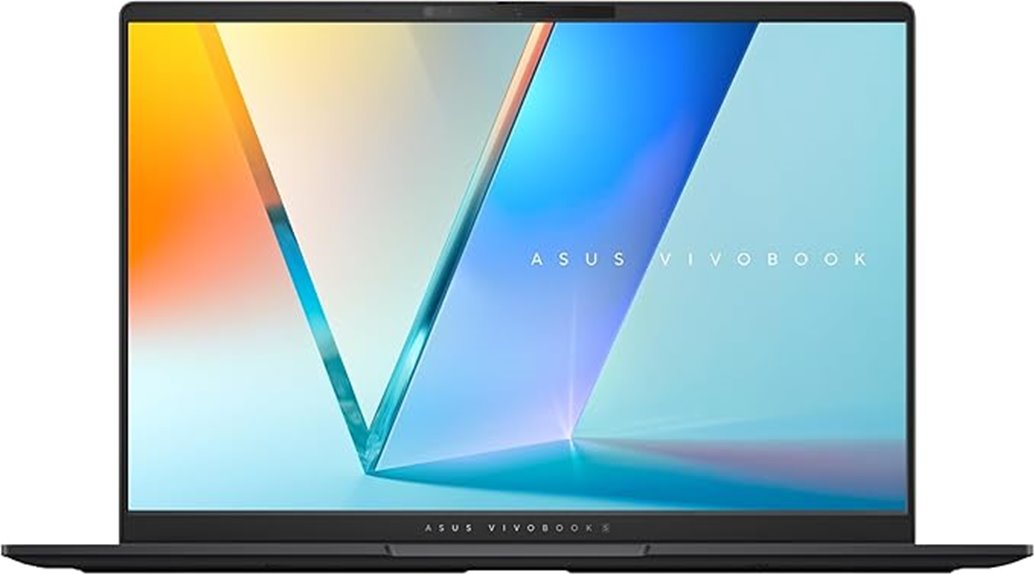Best Laptops for Data Science (Top 5 Picks for 2025)
In 2025, you’ll find top laptop choices for data science that deliver outstanding power and performance. The Apple 2024 MacBook Pro with the M4 chip, Acer Swift X 14, Apple 2025 MacBook Air, ASUS Vivobook S 14 OLED, and Samsung Galaxy Book4 Pro are all excellent options. They boast high RAM, fast SSDs, and stunning displays to handle complex analyses effortlessly. Stick around to explore each model’s unique features and see which one fits your data science needs best!
Quick Guide
- The Apple 2024 MacBook Pro features an M4 chip, offering exceptional performance and long battery life, ideal for data-intensive tasks.
- Acer Swift X 14 combines Intel Core Ultra 7 and NVIDIA RTX 4060, providing powerful graphics and AI capabilities for enhanced data science workflows.
- The Apple 2025 MacBook Air boasts a 15-inch Liquid Retina display and strong performance, making it perfect for multitasking and video editing on the go.
- ASUS Vivobook S offers a lightweight design with an AMD Ryzen 9 processor and vibrant 3K OLED display, catering to portability and visual clarity needs.
- Samsung Galaxy Book4 Pro stands out with 32GB RAM and a 3K AMOLED touchscreen, ensuring efficient multitasking and excellent data visualization capabilities.
Table of Contents
In the interest of full disclosure, we would like to inform you that some links on our website are affiliate links. By clicking on these links and completing a purchase from our partners, we may receive a nominal commission at no extra cost to you. Rest assured, our affiliate partnerships do not compromise the integrity of our editorial content or product evaluations. For further clarification, kindly refer to our comprehensive affiliate disclosure.
What Are the Best Laptops for Data Science to Buy This Year?
Here are my top picks for the best laptops for data science to purchase this year.
1. Apple MacBook Pro Laptop with M4 Chip (14.2-inch, 16GB RAM, 512GB SSD)
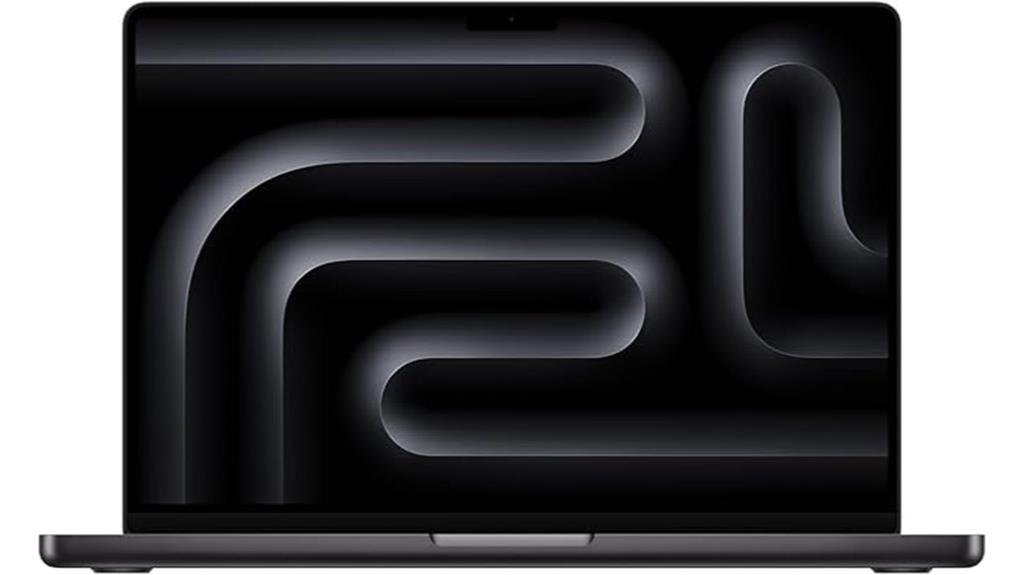
If you’re a data scientist looking for a powerful and efficient laptop, the Apple 2024 MacBook Pro with the M4 chip is an exceptional choice. With its 10-core CPU and GPU, you’ll experience lightning-fast performance for multitasking and running demanding applications. The 14.2-inch Liquid Retina XDR display offers stunning visuals with peak brightness of 1600 nits, ensuring you can analyze data clearly. Plus, the 16GB of unified memory and 512GB SSD storage provide ample space for your projects. Enjoy all-day battery life, seamless integration with Apple devices, and compatibility with essential software like Microsoft 365 and Adobe Creative Cloud.
Best For: Data scientists and professionals requiring high-performance computing for multitasking and demanding applications.
Pros:
- Exceptional performance with the 10-core M4 chip for efficient multitasking.
- Stunning visuals with a 14.2-inch Liquid Retina XDR display featuring high brightness and contrast.
- Seamless integration with the Apple ecosystem and compatibility with essential software applications.
Cons:
- Higher price point compared to some other laptops in the market.
- Limited upgrade options for RAM and storage in the future.
- May require adaptation time for users transitioning from other operating systems.
2. Acer Swift X 14 Laptop (SFX14-72G-77NJ)
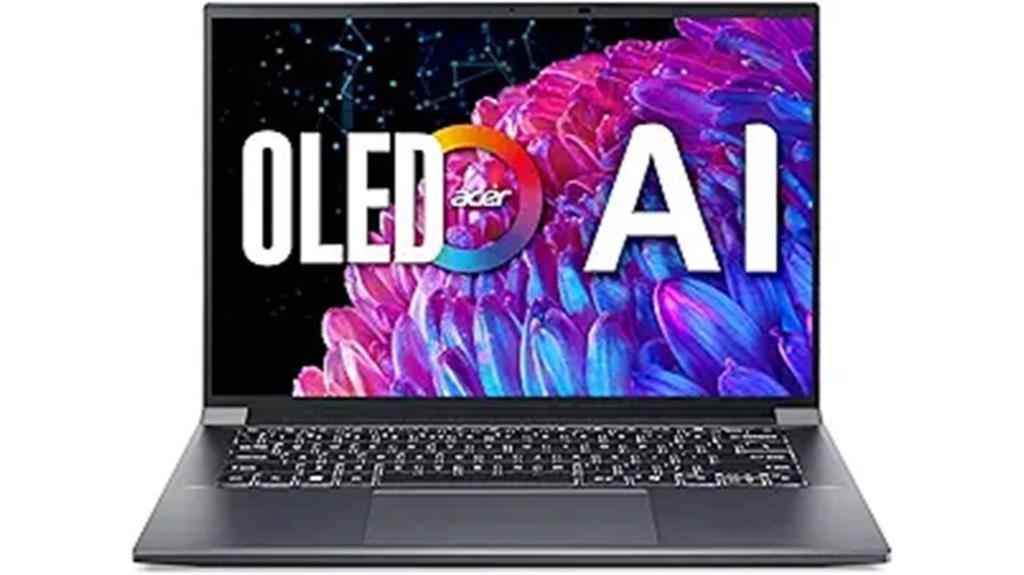
The Acer Swift X 14 Laptop (SFX14-72G-77NJ) is an exceptional choice for data scientists who demand top-notch performance and portability. With its Intel Core Ultra 7 processor and NVIDIA GeForce RTX 4060 GPU, you’ll handle graphically demanding software effortlessly. The stunning 14.5-inch OLED display boasts 2880 x 1800 resolution and TÜV Rheinland certification, ensuring eye comfort during long sessions. With 16GB of LPDDR5X memory and a 1TB SSD, multitasking becomes seamless. Plus, AI features and a high-quality webcam enhance collaboration. Connectivity options like Killer Wi-Fi 6E ensure you stay connected wherever your data science journey takes you.
Best For: The Acer Swift X 14 Laptop (SFX14-72G-77NJ) is best for data scientists and creators who require high performance, portability, and advanced AI capabilities for their demanding workloads.
Pros:
- Excellent performance with Intel Core Ultra 7 processor and NVIDIA GeForce RTX 4060 GPU, ideal for graphically intensive tasks.
- Stunning 14.5-inch OLED display with high resolution and TÜV Rheinland certification for reduced eye strain.
- Ample memory and fast storage with 16GB LPDDR5X RAM and 1TB PCIe Gen 4 SSD for seamless multitasking.
Cons:
- The compact 14.5-inch size may not be suitable for users who prefer larger screens for extensive data visualization.
- Limited upgrade options since the memory is soldered and not user-replaceable.
- Higher price point compared to other laptops without similar performance features.
3. Apple 2025 MacBook Air 15-inch Laptop with M4 chip
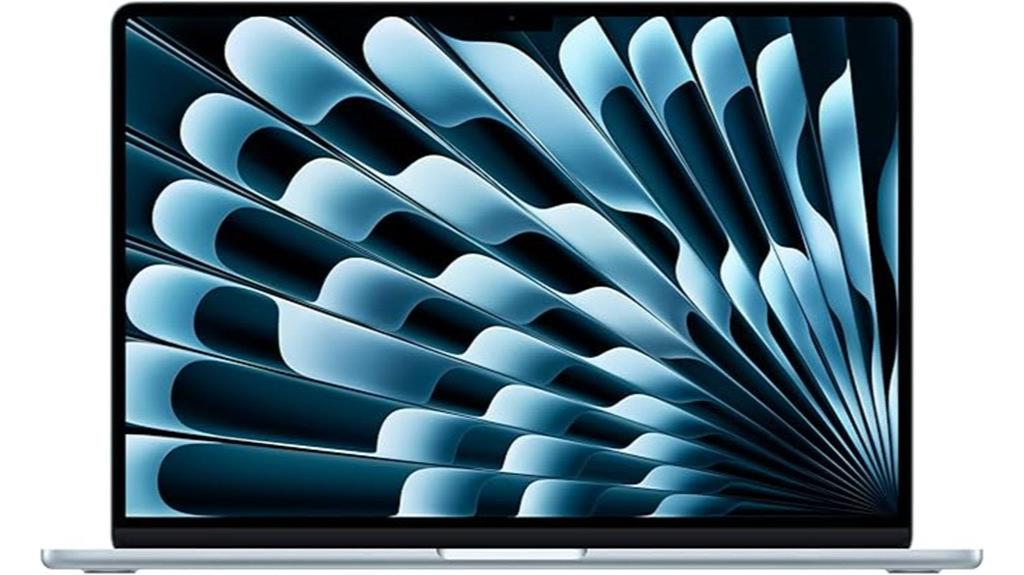
For data scientists seeking a powerful yet portable option, the Apple 2025 MacBook Air 15-inch with the M4 chip stands out as a top choice. With its impressive performance and speed, you’ll breeze through multitasking, video editing, and even gaming. The stunning 15.3-inch Liquid Retina display showcases 1 billion colors, ensuring your visuals are sharp and vibrant. Plus, the 12MP Center Stage camera and six speakers with Spatial Audio deliver remarkable quality for video calls and presentations. With robust connectivity options and up to 18 hours of battery life, this laptop keeps you productive wherever you go.
Best For: Data scientists and creative professionals seeking a powerful, portable laptop with exceptional performance and display quality.
Pros:
- Impressive M4 chip delivers enhanced speed for multitasking, video editing, and gaming.
- Stunning 15.3-inch Liquid Retina display supports 1 billion colors for sharp visuals.
- Long battery life of up to 18 hours allows for productivity on the go.
Cons:
- Limited upgradeability options compared to some competitors.
- Potentially higher price point may not fit all budgets.
- Port selection may require additional adapters for certain peripherals.
4. ASUS Vivobook S 14 OLED Slim Laptop (M5406WA-DS76)
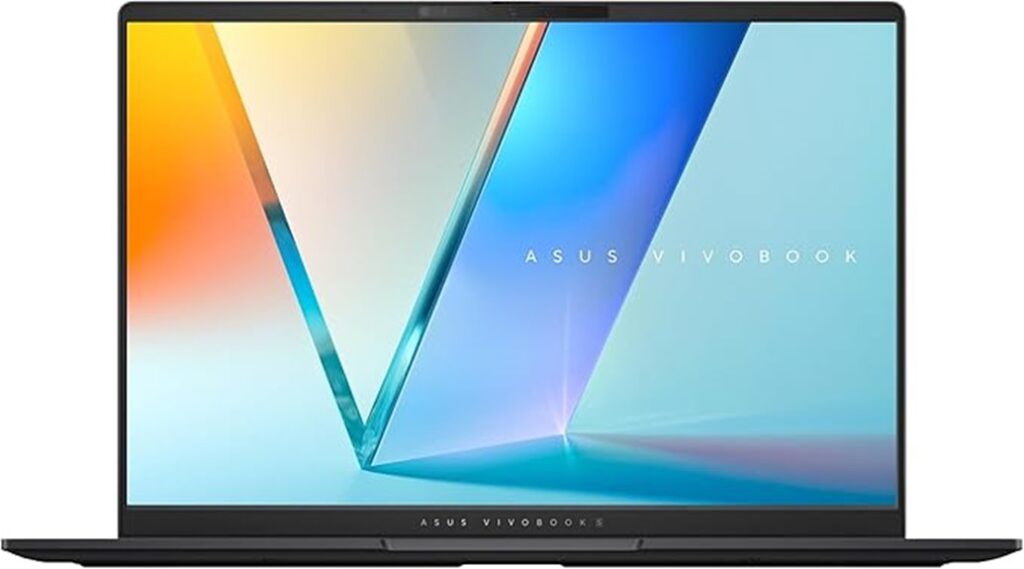
Engineered for data scientists who demand speed and precision, the ASUS Vivobook S 14 OLED Slim Laptop (M5406WA-DS76) stands out with its powerful AMD Ryzen 9 365 processor. With 10 cores and a 45+ TOPS NPU, you’ll experience lightning-fast performance. The 24GB LPDDR5X RAM and 512GB SSD ensure smooth multitasking and ample storage for your projects. Its stunning 14” 3K OLED display delivers vibrant colors and crisp visuals, perfect for data analysis. Weighing just 2.87 lbs and measuring 0.63” thick, it’s incredibly portable. Plus, customizable RGB backlighting enhances your ergonomic typing experience, making it a fantastic choice for data science.
Best For: Data scientists and professionals who require high-speed performance and precise visuals for their analytical tasks.
Pros:
- Powerful AMD Ryzen 9 365 processor with 10 cores and a 45+ TOPS NPU for exceptional performance.
- Stunning 14” 3K OLED display provides vibrant colors and sharp visuals, ideal for data analysis.
- Lightweight and portable design at just 2.87 lbs and 0.63” thick, making it easy to carry for on-the-go work.
Cons:
- Limited upgrade options due to soldered RAM, which may not meet future needs.
- Battery life may vary under heavy workloads, potentially requiring frequent charging.
- Customizable RGB backlit keyboard might not appeal to all users, especially those preferring a more minimalist design.
5. Samsung Galaxy Book4 Pro Business Laptop (NP944XGK-KG4US)
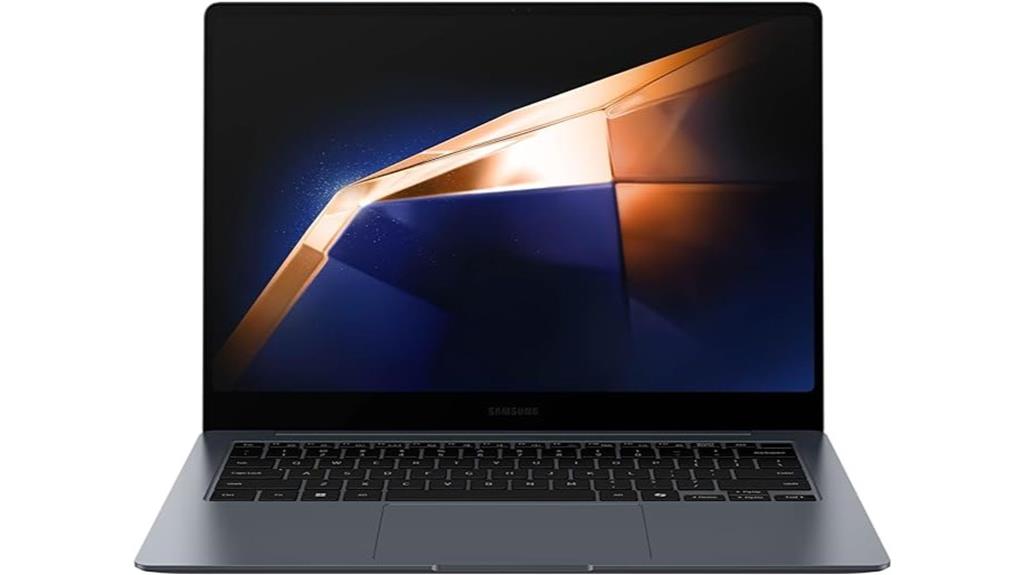
With its powerful Intel Core Ultra 7 processor and impressive 32GB of RAM, the Samsung Galaxy Book4 Pro Business Laptop (NP944XGK-KG4US) stands out as a top choice for data science professionals in 2025. You’ll appreciate the stunning 14-inch 3K AMOLED touchscreen that delivers vibrant visuals. Weighing just 2.71 lbs, it’s perfect for on-the-go productivity. With 1TB SSD storage, you can handle large datasets effortlessly. Plus, its robust security features, like Samsung Knox, keep your data safe. While the price is on the higher side, the performance and design make it a worthy investment for your work in data science.
Best For: Professionals in data science and business who require a powerful, portable laptop with high-quality display and security features.
Pros:
- Exceptional performance with Intel Core Ultra 7 processor and 32GB RAM ideal for multitasking and handling large datasets.
- Stunning 14-inch 3K AMOLED touchscreen provides vibrant visuals and enhances productivity.
- Robust security features like Samsung Knox ensure data protection for enterprise users.
Cons:
- Higher retail price ($1749) compared to competitors offering better specifications at lower prices.
- Limited RAM upgrade options in the US, Canada, and UK, capping at 16GB.
- Perceived low quality of the OEM SSD from Western Digital for the price point.
ALSO READ: Best Laptops for Data Scientists, Best Laptops for Financial Advisors, Best Laptop for Social Media Influencer, Best Laptop for Karaoke, Best Laptop for Running Solidworks, Best Laptop for Pen Testing, Best Laptop for Podcast Editing, Best Laptop for Recording Podcasts, Best Laptop for Researchers, Best Laptop for Multimedia
Factors to Consider When Choosing Best Laptops for Data Science
When you’re choosing a laptop for data science, you need to prioritize several key factors. Processing power, memory capacity, and storage space are crucial for handling large datasets efficiently. Additionally, don’t overlook display quality and battery life, as these can significantly impact your productivity on the go.
Processing Power Requirements
Choosing a laptop for data science isn’t just about brand preference; it requires careful consideration of processing power to effectively handle intensive tasks. Look for multi-core CPUs with high clock speeds, as they’re essential for efficient data manipulation and analysis. The growing importance of GPUs can’t be ignored, especially for deep learning applications, since they can drastically reduce training times for complex models. Aim for at least 16GB of RAM to manage large datasets and multitasking without lag. Opt for SSD storage instead of HDD to benefit from faster read and write speeds, enhancing data loading times and overall responsiveness. Lastly, ensure your laptop can run multiple applications simultaneously, such as visualization tools and database systems, for optimal performance.
Memory Capacity Considerations
Memory capacity is a crucial factor in selecting a laptop for data science, as it directly impacts your ability to handle large datasets and complex computations. For most tasks, a minimum of 16GB of RAM is recommended, but if you’re working with larger datasets or running memory-intensive applications, opting for 32GB or more can significantly enhance performance. Consider laptops with Unified Memory architecture, which optimizes memory allocation between the CPU and GPU, boosting efficiency in data-heavy tasks. Additionally, ensure that the laptop allows for memory upgrades; this future-proofs your investment as project demands grow. Lastly, choose fast memory types like LPDDR5 or DDR5 for better bandwidth and speed, improving your overall data science experience.
Storage Space Needs
As data science projects often demand ample storage for various datasets, it’s essential to consider your laptop’s storage capacity carefully. You’ll want at least 512GB of SSD storage to ensure you have enough space for software, libraries, and datasets. If you’re dealing with extensive data handling, aim for 1TB or more. Fast storage solutions like SSDs significantly improve data access times, which is crucial for handling large datasets and running complex algorithms efficiently. Additionally, many data science tools, such as TensorFlow or PyTorch, can take up extra disk space, so planning for extra storage is wise. Don’t forget that utilizing cloud storage can complement your local setup, providing scalable access to larger datasets without physical limitations.
Display Quality Importance
When working on data science projects, having a high-quality display can significantly enhance your productivity and effectiveness. A high-resolution display of 2880 x 1800 or higher allows for clearer visualization of complex data sets and detailed graphs. Brightness levels of 1000 nits or more improve visibility in various lighting conditions, crucial for data analysis and presentations. Additionally, color accuracy with a wide color gamut, like 100% DCI-P3, ensures accurate color representation, vital for interpreting visual data. A refresh rate of at least 120Hz enhances interactions, especially with dynamic visualizations. Lastly, features like anti-reflective coatings minimize eye strain during long analysis sessions, ensuring consistent visibility in bright environments. Choose wisely to elevate your data science experience.
Battery Life Expectations
Battery life is a crucial aspect to consider for data science laptops, especially if you’re often working away from power outlets. Aim for a laptop with at least 8 hours of battery life to ensure you can work through extended sessions without interruptions. High-performance models might drain power quickly, so look for options with efficient power management features to help extend battery longevity during intensive tasks. Since data science applications, particularly those involving machine learning, can be power-hungry, striking a balance between performance and energy efficiency is key. Additionally, consider laptops with fast charging capabilities to minimize downtime. Adjusting screen resolution and brightness can also optimize usage time, making your work experience smoother and more productive.
Connectivity Options Available
While ensuring your laptop has a robust battery life is important, connectivity options are just as vital for data science tasks. Look for models that offer multiple USB Type-C and USB-A ports to connect various peripherals and external devices seamlessly. Thunderbolt 4 ports are a must for high-speed data transfer, especially when handling large datasets. An HDMI port will also enhance your productivity, allowing easy connections to external displays for multitasking. Don’t overlook microSD card slots; they make data transfer from mobile devices and cameras hassle-free. Lastly, ensure your laptop supports Wi-Fi 6 or above for faster and more reliable wireless connectivity, which is crucial for cloud-based data processing and collaboration on projects.
Portability and Weight
Portability plays a crucial role in the life of a data scientist, especially if you often find yourself working in different locations. You’ll want a laptop that’s lightweight, ideally under 3.5 lbs, to make commuting a breeze. A slim profile, less than 0.7 inches thick, helps it fit easily into your backpack or briefcase without weighing you down. Battery life is another key factor; look for models that offer at least 8 hours of usage to keep you productive during long sessions away from outlets. A display size of 14 to 15 inches strikes a good balance between usability and portability. Additionally, features like fast charging can be a lifesaver, letting you quickly recharge during short breaks.
Operating System Compatibility
When selecting a laptop for data science, the operating system you choose can significantly influence your workflow and the tools you can effectively use. Data science tools like R, Python, and SQL often perform best in Linux environments, which are favored for their flexibility and efficiency with large datasets. While Windows is popular in enterprises, it may require extra setup for certain libraries. On the other hand, macOS provides a Unix-based environment, making it a favorite among data scientists due to its seamless integration with essential tools. Remember, the right operating system can also affect the performance of machine learning frameworks, so choose wisely to optimize processing speed and resource management for your data science tasks.
Frequently Asked Questions
What Operating Systems Are Best for Data Science Laptops?
When choosing an operating system for data science laptops, you’ll find that Linux, especially Ubuntu, offers powerful tools and flexibility. Windows can be good too, but Linux often provides better support for data science applications.
How Much Battery Life Is Ideal for Data Science Work?
For data science work, aim for at least 8-10 hours of battery life. This ensures you can run intensive tasks without constantly searching for a power outlet, allowing you to stay productive throughout your day.
Are Gaming Laptops Suitable for Data Science Tasks?
Yes, gaming laptops are suitable for data science tasks. Their powerful processors and graphics cards handle complex computations efficiently. Just ensure you have ample RAM and storage to support your data-heavy projects effectively.
What Is the Importance of Screen Resolution for Data Science?
Screen resolution’s crucial for data science because it affects clarity and detail in visualizations. Higher resolution lets you analyze complex data sets and spot trends more easily, enhancing your overall productivity and decision-making capabilities.
How Can I Upgrade My Laptop for Better Data Science Performance?
You can upgrade your laptop by increasing RAM, installing a faster SSD, or enhancing the GPU. These changes boost processing speed, improve multitasking, and enhance performance for data-intensive tasks, making your workflow smoother and more efficient.
My Final Opinion
When choosing a laptop for data science, you want power, performance, and portability. The options we’ve reviewed, from the Apple MacBook Pro to the Acer Swift X, each offer unique strengths to meet your needs. Consider factors like processing power, RAM, and battery life based on your specific tasks. Investing in the right machine can make a significant difference in your workflow, so take the time to choose the one that fits you best.
